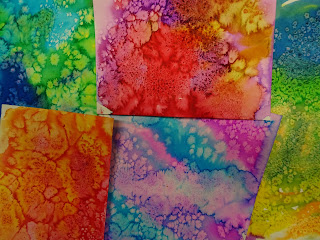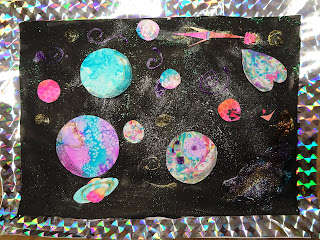So here's the thing. It seems a lot of art teachers right now have been immersed in seasonal projects involving pumpkins or owls. But while I love the autumn, and I like seasonal artwork, my favorite seasonal lessons involve neither owls or pumpkins. So today I'm going to share a couple of my fall faves with you. I am retired, but these are projects I did while I was still teaching full time. I never photographed the student work, but I still have my own samples, so I'll share them with you here. I usually prefer to share student work, but today, this will have to do!

The two scarecrows above, and the one below, are all collages, and were made by me as samples for 3rd grade classes. For the backgrounds (negative space) on the two above, students tore tissue paper into chunks. (The kids selected three colors to use, so if they wanted blue, turquoise and green, for example, that would have been fine; I chose autumn leaf colors for my samples.) Mod Podge or watered down Elmer's Glue-All was used to adhere it to heavyweight white paper. Both work just fine. Students first painted the Mod Podge or glue mix onto the white paper, and then put colored tissue on the wet paper. They then painted over the tissue to seal it.

The collage directly above has a painted background; big brushes were used and tempera paint was applied loosely and expressively. We may have been learning about Van Gogh, but since the sample is a few years old, I can't guarantee it! You'll notice on both the tissue paper backgrounds and the painted background, there is a small white frame on the paper. This is one of my favorite "tricks".
Students draw a frame (or or you can draw it for younger kids) of about 1/2" inside the
edge of the paper. All painting/gluing is done inside the frame. This way,
you will have clean paper edges for carrying, you can lay them on the
floor for drying if you don't have a drying rack, the tables will stay
cleaner since no painting is done at the edges, and the paper won't curl
as much as when it is painted to the edge! Plus, when you hang them
up to display, the artwork has built in picture frames!
Anyhow - when the negative space is dry, it's time for collage. I put out, all around the room, boxes and bins and trays of all kinds of goodies: fabric scraps, wood scraps, toothpicks, wooden sticks, drinking straws, coffee stir sticks, cotton swabs, buttons, rickrack, ribbon, yarn, hunks of burlap, bags of straw, raffia, feathers, pompoms, and so on. (I'm not afraid of a mess.) We discussed the meaning of the word POROUS. I would explain that Elmer's Glue-All holds best for porous items, but non-porous items might fall off, so for non-porous items like plastic buttons, we'd use a stronger tacky glue. Kids were free to get what they need, taking just two or three items at a time, so that they could be sure to get them glued down before class ended. Everyone started with some sort of stick or straw to hold up their scarecrow! I love the independent decision-making necessary, and letting the kids figure out how to put together the clothes and such. Nothing could stick up off the paper (they had to fit in the drying rack); otherwise it was really up to them. Everyone pitched in at cleanup time to get the materials back in their boxes and bins, and shoved them into the storage closet or on the counter for next time, and sponged off any glue that dripped on the tables.

I loved to have my 4th graders draw "naked" trees this time of year, and have done a wide variety of approaches. One approach, charcoal trees, has been featured a few times on the blog, with student samples. You can find a good post about this project
HERE, with student samples. But today, I'm sharing trees painted with tempera.
I am NOT a fan of the "Y" shaped trees that many art teachers favor. Why not? Because none of the trees outside my classroom window were shaped that way! So instead, I taught students how to make trees branch off a central trunk that may or may not split. But it didn't have to! But anyhow, I want to talk about the tempera trees.
In both of the two painted trees above (the one with the orange sky, and the one with the green and purple sky), students started with a land line. It could be straight or curving or angled. Then a trunk was added that extended to the top of the paper; all branches added on extended to the edges as well, filling the space.
Students were give a choice of using warm colors for their tree or sky; cool colors for whichever wasn't painted warm. Then students selected whatever color(s) they wanted for the ground. The photo isn't great, but in the orange sky painting, the tree is blue. White and black were used to shade as desired.
One year, I gave students a different color challenge. Instead of warms and cools; we made neutral paintings, but without using any black. So the challenge was for students to mix browns and grays by using various combos of yellow and violet, green and red, orange and blue. They also were given turquoise and magenta. They were encouraged to also explore combinations of three or even four colors together in varying proportions. I wish I had their work to show you! It's wonderful to watch kids discover that you don't need black to make gray, and that you don't need a bottle of brown paint at all! Below is a closeup of the color of the tree above, painted in this manner.
I have blogged about one other autumn tree project, that uses sand and glue for swirly texture a la Van Gogh. I think the student work was pretty awesome, so I hope you'll hop over to the old post and see their creations! You can find the post
HERE.
That's it for today. Do you have favorite fall projects that do NOT involve pumpkins or owls? That involve a lot of student choice in the process? If you do, I'd love to hear about them!


















































